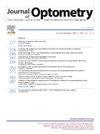Effects of weekly unilateral application of 1% atropine on reducing anisometropia in Chinese children with low myopia
IF 1.8
Q2 OPHTHALMOLOGY
引用次数: 0
Abstract
Purpose
To evaluate the efficacy of weekly unilateral application of 1 % atropine on reducing anisometropia in Chinese children with low myopia.
Methods
In this retrospective cohort study, anisometropic children aged 6–12 years receiving atropine in the more myopic eye for at least 3 months were included in atropine group (n = 150), and baseline matched counterparts without atropine use were included in control group (n = 50). Changes in spherical equivalent refraction (SER), axial length (AL) and other biometric parameters between each visits were analyzed.
Results
At 3 months, anisometropia of atropine group reduced by 0.737 ± 0.030 D (P < 0.001), with SER increasing by 0.528 ± 0.024 D and AL decreasing by 0.118 ± 0.008 mm in the atropine-treated eyes. The changes of SER and AL of the contralateral eyes between the two groups showed no significant difference (P = 0.489 and 0.107, respectively). Initial SER in the atropine-treated eyes was positively associated with the change of SER in those eyes (P = 0.042) and negatively associated with the change of anisometropia in atropine group (P = 0.048). With continuous atropine application for 9 months, anisometropia reduced by 1.212 ± 0.153 D (P < 0.001).
Conclusion
Weekly unilateral 1 % atropine application in the more myopic eye was effective for reducing anisometropia in children with low myopia and would not alter myopia progression in the contralateral eye. Children with lower initial myopia in the treated eye showed more alleviation of myopia in that eye and more reduction of anisometropia.
每周单侧应用1%阿托品对中国低近视儿童屈光参差的影响
目的评价每周一次单侧应用1%阿托品治疗中国低近视儿童屈光参差的疗效。方法回顾性队列研究中,6-12岁的高度近视儿童接受阿托品治疗至少3个月为阿托品组(n = 150),对照组为未使用阿托品的基线匹配儿童(n = 50)。分析两组患者的球等效折射(SER)、眼轴长度(AL)等生物特征参数的变化。结果3个月时,阿托品组屈光参差减轻0.737±0.030 D (P < 0.001),其中SER增加0.528±0.024 D, AL减少0.118±0.008 mm。两组对侧眼SER、AL变化无显著性差异(P值分别为0.489、0.107)。阿托品组患者初始SER与SER变化呈正相关(P = 0.042),与屈光参差变化呈负相关(P = 0.048)。连续使用阿托品9个月,屈光参差降低1.212±0.153 D (P < 0.001)。结论每周1%的单侧阿托品应用于高度近视眼可有效降低儿童低度眼屈光参差,且不会改变对侧眼近视的进展。治疗眼初始近视较低的患儿,该眼近视减轻较多,屈光参差减少较多。
本文章由计算机程序翻译,如有差异,请以英文原文为准。
求助全文
约1分钟内获得全文
求助全文

 求助内容:
求助内容: 应助结果提醒方式:
应助结果提醒方式:


